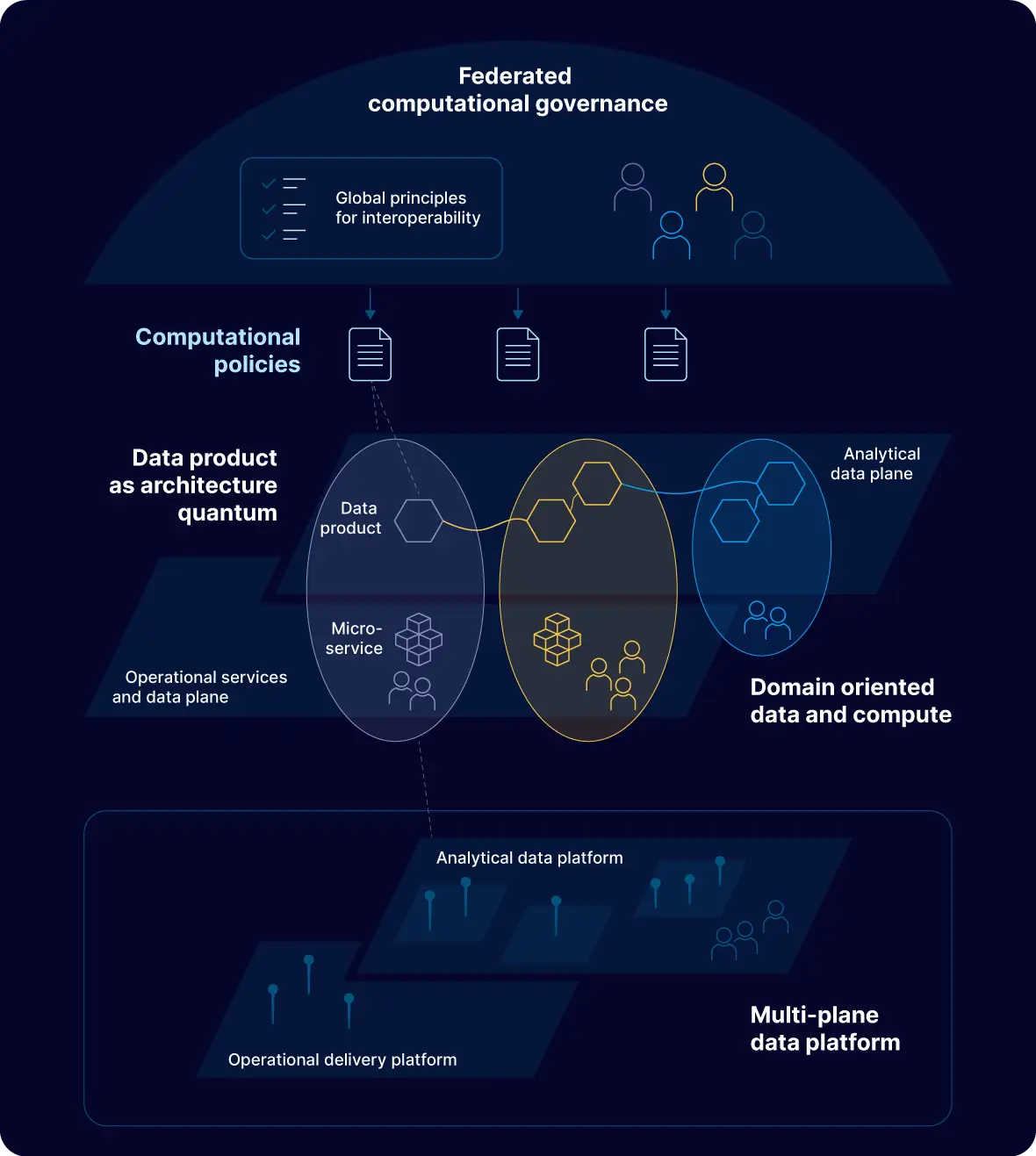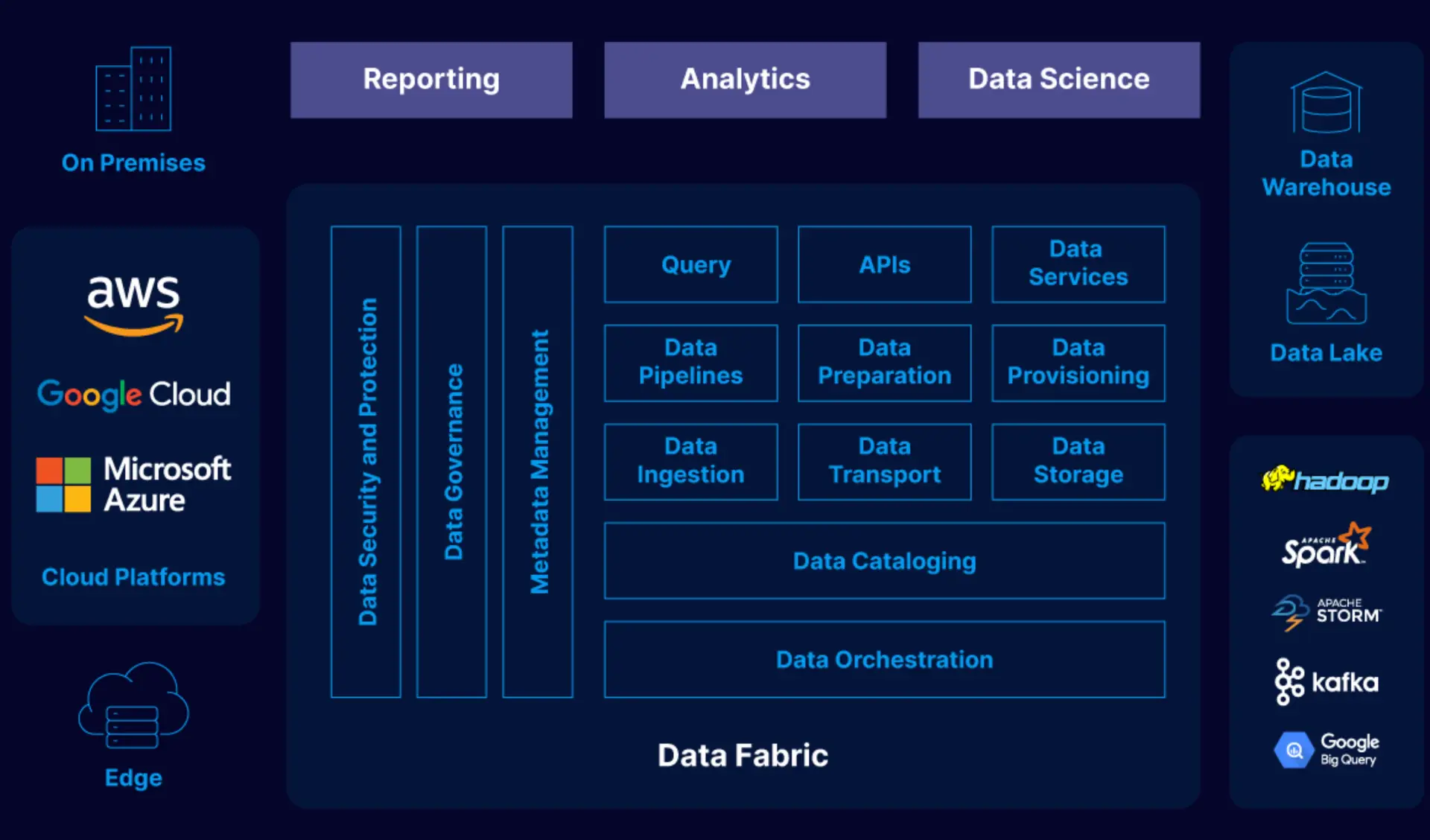Organizations struggle with managing vast amounts of complex data. Traditional methods often fall short, leading to data silos and security vulnerabilities. Innovations like Data Mesh and Data Fabric have emerged as solutions, offering new ways to manage data effectively and derive actionable insights. Central to unlocking the potential of these frameworks is Striim, a platform that facilitates real-time data integration, analytics, and event processing, providing businesses can fully leverage their data.
Overview of Data Mesh

Data Mesh is a decentralized architectural approach designed to address large-scale data management issues by promoting domain-oriented data ownership and self-serve data infrastructure. This approach emphasizes the distribution of data governance and architectural responsibilities across different domains within an organization, treating data as a product.
Business Value:
- Enhanced Agility and Innovation: By empowering domain teams with the autonomy to manage their data, organizations can foster a more agile and innovative environment
- Improved Data Quality and Accessibility: Thinking of data as a product helps to make sure that it is of good quality and easy to use. This makes it more valuable and easy to access for everyone in the organization.
- Scalability: Supports scalable data management practices that can grow with the organization without creating bottlenecks or silos.
Overview of Data Fabric
Data Fabric offers a more integrated and cohesive approach to managing data across disparate sources and environments. Data Fabric uses advanced technology, such as AI and machine learning, to automatically find, manage, and combine data. This gives organizations a single view of all their data.
Business Value:
- Operational Efficiency: Automates data integration and management tasks, significantly reducing manual efforts and streamlining operations.
- Real-time Insights: Facilitates real-time data processing and analytics, enabling organizations to make faster, more informed decisions.
- Enhanced Data Security and Governance: Implements robust data governance and security measures across all data sources, providing data integrity and compliance.
Data Mesh vs. Data Fabric
While Data Mesh and Data Fabric both aim to enhance data management, they differ significantly in their approach and focus.
- Approach: Data Mesh decentralizes data management, giving individual domains or teams control and responsibility for their data. In contrast, Data Fabric uses a centralized approach to provide a unified and comprehensive view of data across the organization.
- Technology vs. Organizational Change: Data Fabric is more technology-centric, leveraging tools and platforms to integrate data. Data Mesh, however, focuses on organizational change, promoting a shift in how data responsibilities are distributed
- API Integration: Data Mesh relies on API-driven integration, requiring developers to write code for data access.
Data Fabric, conversely, favors a low-code/no-code approach, making data integration accessible without extensive coding. The difference between Data Fabric and Data Mesh lies in their respective approaches to data management. Data Fabric and Data Mesh have different focuses. Data Fabric uses automation and integrated technologies to make things easier. On the other hand, Data Mesh empowers teams and promotes data ownership and specialized governance.
When to Use Data Mesh vs. Data Fabric
Data Mesh May Be the Best Option If You:
- Value Domain Autonomy: Your company has specific groups or teams that can handle their information. This encourages a decentralized way of coming up with new ideas and making decisions.
- Seek to Foster Innovation: Your goal is to help teams be more creative and try new things with their data. You want them to be able to easily adjust to changes and take advantage of new opportunities.
- Require Scalability: Your data architecture needs to scale flexibly with your organization, accommodating new domains, data products, and evolving business models without overhaul.
Data Fabric May Be the Best Option if You:
- Need Unified Data Access: You prioritize having a holistic view of your organization’s data to drive comprehensive analysis and informed decision-making across the enterprise.
- Prefer Automated Data Management: Your aim is to make it easier to put together, organize, and protect information from different places and in different ways. You want to avoid doing things by hand and making mistakes.
- Focus on Real-time Insights: Your organization relies on real-time data processing and analytics to drive operations, strategic decisions, and competitive advantage.
Striim’s Role in Supporting Data Mesh and Data Fabric
Striim emerges as a vital thread that seamlessly connects the patterns of Data Mesh and Data Fabric. As companies navigate data management, Striim helps them improve Data Mesh and Data Fabric. This provides a smooth data flow, no matter what architectural approach they use.
- For Data Mesh: Striim facilitates real-time data integration and streaming analytics required for domain-driven architectures. It enables individual domains to access, process, and analyze their data in real-time, supporting the autonomy and agility that Data Mesh promotes. This allows for a more responsive and dynamic approach to data management, where insights can be generated and acted upon quickly.
- For Data Fabric: In a Data Fabric architecture, Striim acts as the backbone for real-time data integration across diverse sources. Striim is an efficient and effective tool for managing large amounts of data by automating its movement and processing. This guarantees that the data view remains current and actionable at all times. It’s a necessary tool for organizations that use the Data Fabric method. It helps them use their combined data to improve operations and gain important insights.
Choosing the Right Path
Deciding between Data Mesh and Data Fabric depends on your organization’s specific needs, culture, and goals for data management. Each approach offers distinct advantages that can help organizations navigate the complexities of modern data ecosystems. You can choose between Data Mesh and Data Fabric to improve your data management. Striim is important for both options as it helps make them successful. Striim’s technology allows organizations to easily integrate and analyze data in real-time. This helps with scalability, security, and getting valuable insights quickly.
Ready to mesh well with your data or weave a stronger fabric? Striim is here to thread the needle between Data Mesh and Data Fabric, providing you don’t get tied up in knots. Let’s untangle your data dilemmas together. Connect with us, and let’s stitch the perfect data management solution for your organization






















